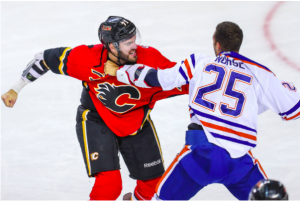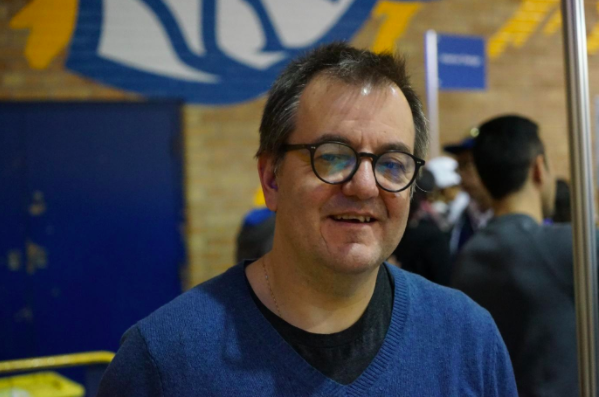
Violence has been a part of hockey since the National Hockey League was founded, almost a century ago.
Many spectators watch the NHL in anticipation of epic ice brawls, but the cost of head trauma can significantly impact the players’ mental and physical health, leading some experts to raise concerns about violence in ice hockey.
Violence in hockey as entertainment
Violence is regarded by many as part of the culture of hockey, according to the NHL News Editor at TheScore, Cory Wilkins.
“It’s a little bit tougher than other sports,” he said.
“Even when a player gets injured, they’re coming back on the ice.”
There is so much audience interest in hockey violence that entire websites are dedicated to covering this aspect of the game.
David Singer, the founder of hockeyfights.com, a website dedicated to chronicling physical conflicts between NHL players said: “The beginning was simple: I wanted to know who fought who, and how many times.”
“It started as a database, a community quickly grew around it and it snowballed into something larger.”
Singer’s website currently has over 55,000 followers on Twitter and more than 100,000 likes on Facebook.
Brad Richardson vs Tomas Plekanec from Arizona Coyotes at Montreal Canadiens Nov 16, 2017 https://t.co/aA9iB6X8F2
— hockeyfights (@hockeyfights) November 17, 2017
(Source: Hockey Fights/Twitter)
He said violence adds an extra element of entertainment to the sport for hockey fan:. “It brings a raw energy to the game like nothing else. Violence for the sake of violence doesn’t do that, but a fight can.”
Singer said fights in hockey can be used as promotion for the sport, but they don’t have to be.
“The website isn’t promotion, it’s more of a chronicle. Everything is there, good and bad,” he said.
Hockeyfights.com was launched in 1999. Since then, Singer said the role of violence as pure entertainment in the sport has diminished.
“The volume of fights is the most obvious change,” he said. “There’s a fraction of the amount of fighting compared to when I first started the site. The fights themselves are different, and the players fighting have changed. Fights are more in-the-moment now than they were a decade or two ago.”
The effects of violence in hockey
Violence in hockey can cause NHL players significant mental and physical harm.
The program director of Sports Media at Ryerson University Joe Recupero directed a documentary last year, called A Dark Room, addressing this issue.
“The genesis of the idea started with a couple of psychiatrists at St. Michael’s Hospital, who specialise in traumatic brain injuries,” Recupero said.
“The twist in it is both those doctors – Dr. Ryan Todd and Dr. Shree Bhalerao – are big hockey guys. They love hockey. But they are also aware of the amount of concussions and injuries they were treating and seeing and that made them want to get the word out. Their passion for the idea sold me.”

Recupero’s documentary follows the story of former hockey player, Max Taylor, whose hockey career was sidelined due to concussions he suffered playing the sport.
The documentary title references the environment doctors recommend for people who suffer concussions. Recupero said he struggled to get funding from major networks due to the controversial subject matter.
“When we were doing this we didn’t have any deals to get funding. We were relying on small medical research grants.”
The documentary was eventually picked up by the National Film Board after they were shown a preliminary cut.
Recupero said the documentary aimed to reduce the stigma behind mental illness suffered by players as a result of head injuries, as well as educating people about the symptoms and dangers of concussions in the sport.
“It was only when we were working on it and talking to people that I realised I’d had [a concussion] and hadn’t known. I’m someone who’s grown up around sports and played sports and I’m the program director for sports media [at Ryerson], and I didn’t even know this,” he said.
“So, I really thought the urgency of the message was there … in terms of getting the information about it out and what can happen if you don’t realize what’s happened to you, and you just shrug it off.”
The future of violence in hockey
A Dark Room also discusses what the NHL can do to address the issue of violence in the game going forward.
“[Dr. Bhalerao] and [Dr. Todd] talk in the documentary about creating better protocols at a grassroots level,” Recupero said.
“If you actually start enforcing protocols and better training at a younger age, with young athletes, then it becomes a way of life, as opposed to trying to catch up with it in later life,” he said.
Head Coach of men’s hockey at York University, Russ Herrington, is putting this philosophy into practice.
“In this day and age, if you come in and watch university hockey, there is next to no fighting,” Herrington said.
“Society is evolving. We are understanding more and more how those things are dangerous, not only immediately for the players, but as they get older and in the long-term.”
But Herrington also said discussion of the mental and physical risks of the sport is still something that could be improved.
“Overtly, do we talk about it? No.” he said.
Changes are also being made by NHL teams and officials to improve the safety of players.
Singer recently produced the Netflix documentary, Ice Guardians, which examined the role of “enforcers” – players put on teams primarily to fight in the NHL.
He said “enforcers” in the NHL are now rare, and players are currently chosen and valued primarily for their hockey skills.
“Enforcers, for the most part, are gone,” Singer said.
“Very few players would have fighting listed as their top attribute anymore.”
(Source: Upstream Flix/YouTube)
Andrew Allen is the goalie coach of the Buffalo Sabres and he believes the NHL has also evolved the rules to protect its players.
“They’re changing the rules here and there to try to make it safer all the time,” he said.
Ultimately, Allen said, hockey is a competitive physical sport: “There’s always going to be some element of violence to it.”
Recupero said he hopes the NHL will continue progress in safety standards and awareness in their second century.
“You want to make the game safer and better, and I think things are moving that way. There was a time when people didn’t wear helmets. So, everything keeps moving, hopefully, in the general direction of improvement.”

Leave a Reply